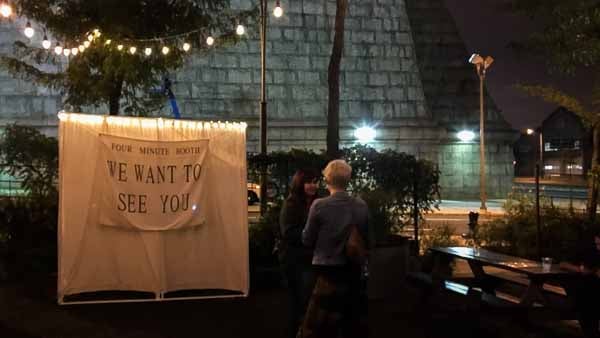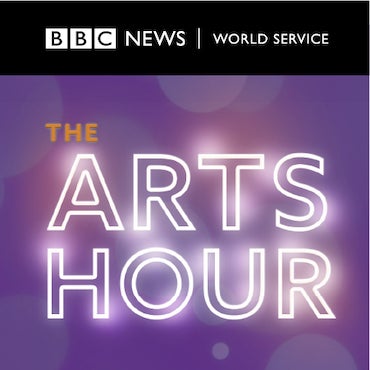Accelerating intimacy between strangers: artists experiment with the power of eye contact
Listen
Inside the Four Minute Booth
You know that old saying, ‘the eyes are the window to the soul’? Well, during Philadelphia’s Fringe Festival this past week, two artists literally took a closer look into that, and whether a simple act, a mutual gaze, could accelerate feelings of closeness or intimacy between people who don’t know one another. They didn’t need much. Just some PVC piping, a sheet, a stopwatch, and strangers. Yes, strangers, who are willing to participate in this experiment of sorts.
“We’re not scientists,” Danielle Gatto cautions.
“We were inspired by science and we want to create a space for people to be able to connect,” echoed her partner,” Makoto Hirano.
That inspiration came to the two theater artists about a year ago, thanks to reading a really popular New York Times column Modern Love.
One of its most popular stories, To Fall in Love With Anyone, Do This by Mandy Len Catron, was about two characters who, drawing on the experiments of some psychologists, answered a series of personal questions over the course of an evening. The guided conversation was aimed at accelerating intimacy between people who don’t know each other. The final activity, though, involved no words, just looking into one another’s eyes, silently, for four minutes.
“I’ve skied steep slopes and hung from a rock face by a short length of rope, but staring into someone’s eyes for four silent minutes was one of the more thrilling and terrifying experiences of my life,” Catron wrote in her fiction essay.
This idea of mutual gazing struck a chord with Hirano and Gatto. Could such a simple act build connections between strangers? Other artists have been drawn to experimenting with this, too.
“You can’t do this in your normal life,” said Gatto. “You can’t just sit there and stare at someone in your normal life, especially a stranger. That would be crazy.”
Enter the four minute booth.
The two recently set up the art installation in an outdoor beer garden, under an almost full moon by Philadelphia’s iconic Ben Franklin Bridge.
The idea is simple: invite strangers to sit across from one another and look into each others’ eyes, silently, without interruption for four minutes.
Gatto and Hirano stress that this booth is not meant to be a romantic prompt. They’re not looking to make strangers fall in love. They just want to try and facilitate positive connections between people (as an aside, Gatto and Hirano are married. By the time the two had this idea, they had already spent plenty of time gazing into one another’s eyes for extended periods).
On the first night of the booth, some people came over by chance. Others like Kathy Huong showed up on purpose.
“I’m a little excited, nervous,” said Huong. “I don’t think I’ve held eye contact with anyone like that for that long.”
“Four mintues is a long time,” said Tim Wilson, who also showed up to participate.
As Dr. Kai MacDonald, a psychiatrist associated with the University of California-San Diego put it, mother nature has spent a lot of time and care creating these magic portals that are our eyes.
“The neurobiological importance of eye contact and direct gaze really can’t be underestimated,” MacDonald said.
Scientists have been well aware of their power for ages. They’re like the screen of an iPhone, said MacDonald, with a huge amount of data processing going on behind that curtain, that screen of consciousness, assessing trustworthiness and other dynamics with the person on the other side. A momentary flash of eye contact, let alone four minutes, can reveal a lot.
An extended mutual gaze is not a positive experience for everyone. An early trauma event or psychological condition can affect this. A gaze can convey a perceived threat. But MacDonald said if circumstances are right, an extended gaze can tap into an unconscious establishment of a safe relationship and potentially help someone feel positively received and accepted, unconditionally.
That can create a unique bond, with the eyes sending safety signals to the brain and activating certain parts like the amygdala, which is associated with mediating and interpreting eye contact.
A sustained gaze has the potential to release chemicals, like oxytocin, which is sometimes called the “cuddle hormone” because it can make us feel safe and loved.
Meanwhile, experiments by researchers like James Wirth at Ohio State University, have found that averted eye contact in other scenarios has the potential to result in feeling rejected and even isolated.
“Given that we really need to be in relationships to be able to survive, and get the comfort that we need, that eye gaze is basically saying ‘hey, I find you to be valuable, close and important, and I want to have that relationship w you,” said Wirth. “And I think when we even take short circumstances of individuals meeting, such as at an exhibit [like Gatto and Hirano’s four minute booth], it’s someone getting that unique experience, and instantly having a connection with someone else through going through this eye gazing task.”
So then when one really thinks about what love is, Dr. MacDonald reflected, at its core is this primal attachment system, a force that conveys safety and trust. It’s one that starts with that mother infant bond, that beautiful, joyous extended mutual gaze that connects the two.
Throughout the evening, participants in the four minute booth seemed to be having a positive experience. For most of the evening, Gatto hovered near the booth, stopwatch in hand, keeping tabs on those inside.
Beep, beep!
“Your four minutes are up, you can exit the booth whenever you’re ready,” she’d say, standing a couple feet away.
Two don’t come out right away.
“Aw, I just heard someone say ‘me too!’ And they both started laughing,” said Gatto, smiling.
Success.
Others have stuck around to socialize with friends they know, or the stranger they just held eye contact with in that booth.
At one point, as Gatto looks for another two people who don’t know each other, she turns to me, the person putting together this story.
“So you’re going to do it right?”
“Oh gosh, I guess I have to, right?” I respond.
I’m nervous, but at the same time, curious.
“It’s only four minutes, and it’s nothing to be scared of,” she responds.
Right.
Before I know it, Gatto introduces me to someone I’ve never met before.
Listen to what happened in the above audio story.
The Four Minute Booth will be set up Friday, Sept. 23 and Saturday, Sept. 24, from 8 to 11 p.m. at FringeArts’ Haas Biergarten.
WHYY is your source for fact-based, in-depth journalism and information. As a nonprofit organization, we rely on financial support from readers like you. Please give today.



